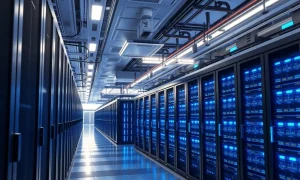The construction industry stands on the brink of a monumental transformation. AI in construction is rapidly shifting traditional, reactionary processes towards predictive precision. This evolution promises significant advantages for businesses and entrepreneurs alike. It enables smarter, faster, and more sustainable project delivery, fundamentally reshaping how we build infrastructure.
Leading this innovative charge is Converge. Their advanced suite of AI-driven solutions digitally manage concrete in real time. These technologies do more than just accelerate build timelines. They also optimize resource use and dramatically reduce embodied carbon. Such advancements resonate deeply with tech-savvy readers who value automation, sustainability, and smart infrastructure solutions.
Through strategically embedded sensors and sophisticated machine learning, Converge facilitates live data streams and accurate forward-looking forecasts. Their systems are fundamentally changing how site teams understand crucial elements. This includes curing cycles, mix performance, and structural readiness. Consequently, a new paradigm emerges where autonomous, data-proactive construction is quickly becoming a reality.
AI in Construction: The Rise of Smart Sensor Networks
Accurate data forms the bedrock of any intelligent system. Converge’s Signal System introduces fully embedded, wireless sensors directly into the heart of the concrete pour. These sensors capture vital temperature and strength data in real time. This immediate feedback provides unprecedented insight into the concrete’s early life.
Furthermore, Helix adds another critical layer to this data collection. It functions as a long-range, reusable sensor network. Helix can transmit data up to 1.5 miles. This ensures consistent data acquisition even on sprawling construction sites. Maintaining connectivity across large areas is often a challenge, but Helix overcomes it effectively.
The Mesh system further enhances overall connectivity. It operates as a robust, reusable backbone. This system efficiently collects and relays performance data, even across noisy network environments. Together, these sophisticated sensor systems eliminate traditional blind spots. They empower comprehensive site visibility, providing project managers with unparalleled control and clarity.
Real-Time Concrete Intelligence with ConcreteDNA and Cure
At the core of Converge’s offering lies ConcreteDNA. This powerful platform aggregates all sensor feeds. It then transforms this raw data into intuitive dashboards and actionable insights. This centralization of information simplifies complex data, making it accessible to site teams.
Crucially, Cure, ConcreteDNA’s AI counterpart, builds upon this rich dataset. It precisely predicts when concrete will achieve its critical strength. This often signals safe formwork removal up to 40% faster than conventional methods. The accuracy is remarkably high, consistently within ±5%. This level of precision minimizes risks and maximizes efficiency.
Cure leverages a combination of data points for its predictions. It considers local weather patterns. It also incorporates historical curing data from similar projects. Most importantly, it uses live sensor readings. This comprehensive approach allows teams to pre-emptively schedule next steps with confidence. For example, this technology successfully powered major projects like the London City Airport expansion. It delivered significant productivity gains and kept time-critical operations precisely on track. This demonstrates the tangible benefits of AI in construction for large-scale infrastructure.
Optimizing Materials: Mix AI for Sustainable AI in Construction
The benefits of Converge’s technology extend beyond just time savings. Their Mix AI harnesses predictive artificial intelligence to recommend optimal concrete mixes. These recommendations meet specific performance requirements. More significantly, they also achieve substantial reductions in embodied carbon.
Cement production contributes approximately 8% of global CO₂ emissions. Therefore, Mix AI’s capability to lower this environmental impact is deeply significant. It offers a practical pathway towards greener construction practices. This aligns perfectly with global sustainability goals.
Mix AI works closely with industry partners. Collaborations with companies like Stanley Black & Decker and Tarmac highlight its effectiveness. These partnerships demonstrate how smarter mix choices can dramatically reduce environmental impact. This is achieved without compromising any structural integrity or performance standards. It exemplifies how AI in construction can drive both efficiency and ecological responsibility.
Accelerating Construction with AI-Driven Autonomy
When real-time sensor networks, strength-predicting AI, and mix optimization capabilities unite, construction workflows advance rapidly. This collective power moves projects closer to full automation. Imagine concrete curing faster than anticipated. This progress is surveyed and forecasted on-site by reliable technology. Such advancements enable leading teams, like Laing O’Rourke, to shave days off project schedules.
Prediction tools ensure that critical interventions happen at the precise optimal moment. This minimizes idle resources, which is a common drain on project efficiency. It also maximizes throughput, accelerating project completion. Furthermore, these integrated systems significantly reduce the overall carbon footprint of construction activities.
These advances are not merely theoretical concepts. They represent tangible, site-active automation solutions. They offer clear competitive advantages in a demanding industry. This proactive approach, driven by AI in construction, ensures projects are completed more efficiently and sustainably.
Implementing AI in Construction: A Practical Guide
Making this transformative shift tangible begins with structured integration. Businesses must adopt a strategic approach to deploying these advanced systems.
- Deploy sensor systems strategically: Use the Signal system for embedded readings within the concrete. Helix is ideal for wide geographical coverage, ensuring data transmission across vast sites. Mesh provides robust, stable network coverage, especially in challenging environments.
- Establish ConcreteDNA and train teams on Cure workflows: Interpret the AI-driven forecasts accurately. Set safe and realistic timelines based on predictive insights. Automate alerts for critical milestones, ensuring timely action.
- Leverage Mix AI: Refine material choices based on performance and environmental goals. Continuously monitor impact metrics. These include both carbon reduction achievements and overall cost efficiency gains.
- Measure ROI: Quantify the return on investment through clear metrics. Track time-savings achieved. Evaluate productivity improvements. Assess the sustainability outputs, such as reduced carbon emissions. Iterate on these processes for continuous enhancement and optimal results.
The Future of Concrete: Tech-Driven and Intelligent
Artificial intelligence is not just powering mobile applications. It is fundamentally shaping the infrastructure of tomorrow. Converge’s comprehensive technology suite powerfully demonstrates this fact. It shows how real-time monitoring, predictive analytics, and data-guided mix design can bring unprecedented intelligence directly to concrete.
The construction industry increasingly demands agility, efficiency, and environmental conscience. In this evolving landscape, these advanced systems provide more than just a performance edge. They establish a robust foundation for sustainable growth. For forward-thinking industry professionals, this is not simply about building smarter structures. It is about actively constructing a future where physical infrastructure and digital intelligence merge seamlessly, driven by powerful AI in construction innovations.
Frequently Asked Questions (FAQs) about AI in Construction
Q1: What is real-time concrete intelligence?
Real-time concrete intelligence involves using embedded sensors and AI to monitor concrete properties like strength and temperature as it cures. This data is instantly analyzed to provide actionable insights, allowing for faster decision-making and optimized construction processes.
Q2: How does AI in construction reduce project timelines?
AI, specifically systems like Converge’s Cure, accurately predicts when concrete will reach critical strength. This allows for earlier, safer formwork removal, often accelerating this step by up to 40%. Such precision minimizes waiting times and keeps projects moving efficiently, significantly shortening overall timelines.
Q3: What role does Mix AI play in sustainability?
Mix AI uses predictive analytics to recommend concrete mixes that meet performance requirements while also significantly reducing embodied carbon emissions. Given that cement production is a major source of CO₂ emissions, Mix AI helps construction companies achieve their sustainability goals without compromising structural integrity.
Q4: How accurate are AI predictions for concrete strength?
Converge’s Cure system, for instance, predicts formwork readiness with an accuracy of ±5%. This high level of precision, based on live sensor data, historical curing patterns, and local weather conditions, ensures safety and reliability in scheduling subsequent construction phases.
Q5: What are the key components of Converge’s AI system for concrete management?
Converge’s system includes several core components: the Signal, Helix, and Mesh sensor networks for data collection; ConcreteDNA, the central platform for data aggregation and dashboards; Cure, the AI engine for predicting concrete strength and optimizing timelines; and Mix AI, which recommends sustainable concrete mixes.






















